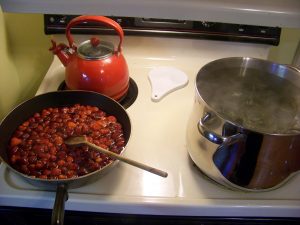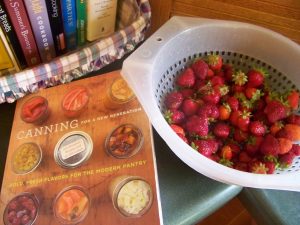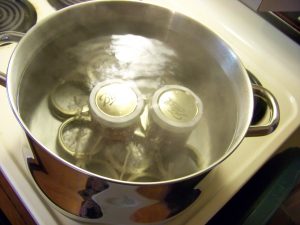In the words of the great Candi Staton, self-preservation is what’s really going on today. Or what went on yesterday, for the first time ever in the Cheapskate Intellectual kitchen. But it won’t be the last.
 Following the directions in the super-easy and super-fun book CANNING FOR A NEW GENERATION, I rendered a colander full of strawberries straight from my patch (augmented with some of last year’s frozen) into some gorgeous preserves that represent to me a huge celebration-worthy paradigm shift and further progression toward Cheapskate Intellectualsustainableradicalhomemakerism if not a, um, triumph of production scale.
Following the directions in the super-easy and super-fun book CANNING FOR A NEW GENERATION, I rendered a colander full of strawberries straight from my patch (augmented with some of last year’s frozen) into some gorgeous preserves that represent to me a huge celebration-worthy paradigm shift and further progression toward Cheapskate Intellectualsustainableradicalhomemakerism if not a, um, triumph of production scale.




 I’ll come clean: these two little jars, plus 3/4 of another one I didn’t totally fill and so am going to be eating out of the fridge, do represent the total yield. But now I know not only that I can do it, but that it is EASY.
I’ll come clean: these two little jars, plus 3/4 of another one I didn’t totally fill and so am going to be eating out of the fridge, do represent the total yield. But now I know not only that I can do it, but that it is EASY.
And next time I will have an additional tool: an actual canning pot with rack and jars, even, that I brought back to Iowa from a trip home to Alabama several years ago. They’ve been in the basement ever since. I forgot they were there till I was done with this batch, but now they’re scrubbed and ready to go. I remember my mom excavating them from the toolhouse where they’d been sitting forlornly since God knows when, rusty and dusty and caked with dirt-dauber nests, and pressing them on me: “if you’re going to start gardening, you really should try canning,” she said. “I used to do it and just… ran out of time.” There was a semi-defensive, semi-wistful look on her face: I could see her turning over, as I’ve done since then, the economies of time we’re actually involved in, what all our Wordsworthian getting and spending is really about and what it’s really worth.
Especially since I do believe these pots belonged to her grandmother, a sweet Pennsylvania lady who had the rare gift of being thrifty and domestically able without being passive-aggressive, small in spirit, shrunk down by the realities of saving and managing (which can be a hard balance to strike.) Tada, as we all called her, could whistle down a taxi with two fingers on a city street. In our hallway hung a portrait of her as a young woman, the hair she habitually wore in a high bun loose and flowing past her waist. She and her beloved husband – our Grampa – drove our pony carriage up and down our farm driveway whenever they came South. I sat in the back, dangling my feet and watching the familiar world roll backwards, listening happily to stories about when people traveled in cars or by horse and carriage in their little town, when you could choose either one. A horse-crazy kid, I couldn’t imagine anything more fun than driving this pony to school. And a neatnik/control-freak-at-worst from an early age (the double curse of the Virgo oldest child), I appreciated their old-school Yankee orderliness: unfailingly sweet and patient, Grampa was also known for chewing every mouthful of food twenty-five times and storing his shovels upright in buckets of sand to keep them from rusting. But they were too polite — and too sanguine about human variety — to cavil at the chaos of our Southern farm household: dogs and cats and people in and out through the screen door, watermelon rinds stacked on the counter to be pitched over the fence for the horses, shotguns leaning in the corner by the door (“gonna put that away in just a minute.”)
It makes me smile to think about using Tada’s pots — and the best habits of Tada’s generation, that modest and thrifty optimism — to knit myself into a type of economy of doing, making, using, and sharing that I can live with. Literally.
Love this – it is really fascinating how work like canning can leave us with the sweet actual fruits to enjoy later, as well as the pride and pleasure of our own self-sufficiency. This carries over to everything we do, reminding us when we feel helpless or adrift in other areas of our lives I always feel better after time in the kitchen–no matter what mood I had when I began . . .
Yes, indeed. I agree COMPLETELY. Well said! Thanks for reading! A
I love canning things–making pickles especially. It reminds me of my grandparents too. Will have to check out Canning for a New Generation. Thanks, Amy!
Yes, you would love CFANG. I’m gonna make the apricot and vanilla preserves next!!!!!!! xo a
I love the way these rituals connect us to those who came before us. It’s the same feeling I get whenever I cook one of my grandma’s recipes, use my granddad’s old spade, or transplant old-fashioned flowers (peonies, irises) from my families’ gardens.
Perhaps we do these things in pursuit of thriftiness or for the sense of accomplishment — both worthy goals — but I’m struck by how they did these things as a matter-of-course, without show or fanfare, or use of the words “sustainability” or “green.” Perhaps, in time, it will be the same for us as we embrace these old practical arts.
I can recall times when I practically broke my arm patting myself on the back for my great potato crop, canning 12 quarts of tomatoes, or starting flowers from seed. And then was quickly brought down to size when I realized my grandma did all this stuff (probably before breakfast), farmed with my grandpa, taught multiple grade-levels in a one-room school house, and raised two kids.
But, three cheers to all of us for doing our part.
If you want to peruse something fascinating, check these out from the Iowa State University digital collection — historical/suffragist cookbooks featuring recipes from Jane Addams, Carrie Chapman Catt, and others from the movement.
http://cdm16001.contentdm.oclc.org/cdm/search/collection/p15031coll26